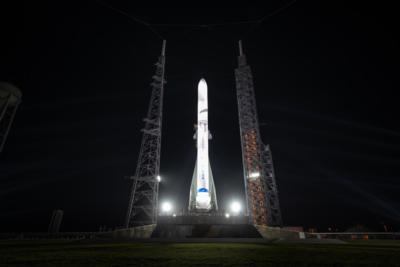Sun, Feb 25, 2024
New Glenn Is Named After John Glenn, The First American To Orbit Earth
Blue Origin's New Glenn vehicle was successfully rolled out and upended for the first time, this week, on the pad at Launch Complex 36 (LC-36). This milestone represents the first view of the advanced heavy-lift vehicle, which will support a multitude of customer missions and Blue Origin programs, including returning to the Moon as part of NASA’s Artemis program.

Blue Origin notes that everything on the pad is real New Glenn hardware. The upending is one in a series of major manufacturing and integrated test milestones in preparation for New Glenn’s first launch later this year. The test campaign enables their teams to practice, validate, and increase proficiency in vehicle integration, transport, ground support, and launch operations. These tests do not require engines, which are hotfiring at the 4670 Test Stand in Huntsville and Launch Site One in West Texas.
The journey to the pad began in December when New Glenn’s first-stage modules were transported from the factory to the Integration Facility nine miles away. The tests will conclude in the coming weeks following several demonstrations of cryogenic fluid loading, pressure control, and the vehicle’s venting systems. Blue origin's launch pad and ground systems are complete and will be activated for the first time during the test campaign.
New Glenn is named after John Glenn, the first American to orbit Earth. The rocket stands more than 320 feet high—roughly the height of a 30-story building—and features a seven-meter payload fairing, enabling twice the volume of standard five-meter class commercial launch systems. The fairing is large enough to hold three school buses. Its reusable first stage aims for a minimum of 25 missions and will land on a sea-based platform located roughly 620 miles downrange. Reusability is integral to radically reducing cost-per-launch.
The vehicle is powered by seven of Blue Origin’s BE-4 engines, reportedly the most powerful liquid oxygen (LOX)/liquefied natural gas (LNG) engine developed since Saturn V’s F1 engines. LNG is touted as being cleaner-burning and higher-performing than kerosene-based fuels.
Blue Origin has several New Glenn vehicles in production and a full customer manifest. Customers include NASA, Project Kuiper, Telesat, and Eutelsat, among others. Blue Origin is certifying New Glenn with the US Space Force for the National Security Space Launch (NSSL) program to meet emerging national security objectives.
More News
He Attempted To Restart The Engine Three Times. On The Third Restart Attempt, He Noticed That Flames Were Coming Out From The Right Wing Near The Fuel Cap Analysis: The pilot repor>[...]
Make Sure You NEVER Miss A New Story From Aero-News Network Do you ever feel like you never see posts from a certain person or page on Facebook or Instagram? Here’s how you c>[...]
From 2009 (YouTube Edition): Leading Air Show Performers Give Their Best Advice for Newcomers On December 6th through December 9th, the Paris Las Vegas Hotel hosted over 1,500 air >[...]
Aero Linx: NASA ASRS ASRS captures confidential reports, analyzes the resulting aviation safety data, and disseminates vital information to the aviation community. The ASRS is an i>[...]
“For our inaugural Pylon Racing Seminar in Roswell, we were thrilled to certify 60 pilots across our six closed-course pylon race classes. Not only did this year’s PRS >[...]
 NTSB Final Report: Rutan Long-EZ
NTSB Final Report: Rutan Long-EZ ANN FAQ: Turn On Post Notifications
ANN FAQ: Turn On Post Notifications Classic Aero-TV: ICAS Perspectives - Advice for New Air Show Performers
Classic Aero-TV: ICAS Perspectives - Advice for New Air Show Performers ANN's Daily Aero-Linx (06.28.25)
ANN's Daily Aero-Linx (06.28.25) Aero-News: Quote of the Day (06.28.25)
Aero-News: Quote of the Day (06.28.25)



